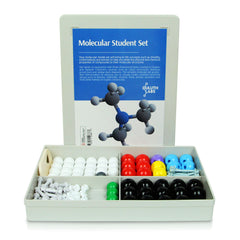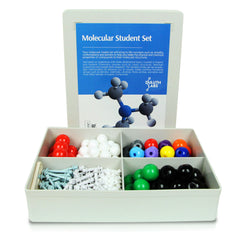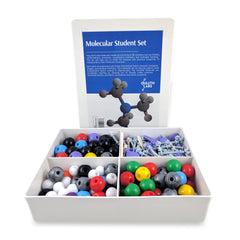Dopamine: The Mood Booster
Dopamine is naturally present in the body and acts as a chemical messenger that is particularly involved in transmitting signals to and from the brain. It helps in maintaining coordinated movements, stabilizes mood, regulates sleep, keeps us focused and attentive, and also plays an important role in one’s behavior and cognition. Moreover, it also functions as a “feel-good” chemical that is released whenever we are engaged in a pleasurable activity or situation. As such, it is frequently linked to consumption of certain foods (such as chocolates), intake of some drugs, and engagement in some sensation-seeking activities. Recent studies have also demonstrated that high self-esteem can be associated with sufficient levels of dopamine in the body.
What does Dopamine look like in Chemistry?


Let’s Get Building!
Using your Student Molecular Set from Duluth Labs let’s create Dopamine! You’ll need:
-
8 Carbon Atoms
-
1 Nitrogen Atom
-
2 Oxygen Atoms
-
11 Hydrogen Atoms
-
11 Small Connectors (compact short bonds for hydrogen)
-
8 Medium Connectors (single bonds)
-
6 Long Connectors (double bonds)
-
Molecular Tool (for Disassembly)
Put aside all the atoms and connectors needed.
Let’s Start Building With Our Benzenediol Portion!

Let’s start!
Steps:
-
1

1. Using one carbon atom (Carbon 3) then place a hydrogen atom above it using a small connector.
-
2

2. Then, grab another carbon atom (Carbon 4) then attach this to the right of Carbon 3 using 2 long connectors.
-
3

3. Place another carbon atom (Carbon 5) below Carbon 4 using 1 medium connector. Then, get a hydrogen atom and attach this to Carbon 5 using a small connector.
-
4

4. Attach a carbon atom (Carbon 6) to Carbon 5 using 2 long connectors. Add a hydrogen to Carbon 6 using a small connector.
-
5

5. Add another carbon atom (Carbon 1) to Carbon 6 using 1 medium connector. Attach an oxygen atom to Carbon 1 using a medium connector. Then, place a hydrogen atom on this oxygen using a small connector.
-
6

6. Get another carbon atom (Carbon 2) then attach this above Carbon 1 using 2 long connectors. Place an oxygen atom on Carbon 2 using a medium connector. Then, add a hydrogen atom to this oxygen using a small connector.
-
7

7. Join Carbon 2 and Carbon 3 together using a medium connector.
-

Yay! We've just built our 6-membered substituted ring!
Let’s now continue building our ethylamine portion.
We will begin with Carbon 1’ and we will build this portion towards the right.

Steps:
-
1

1.Get one carbon atom (Carbon 1’) then attach this to Carbon 4 of benzene ring using a medium connector. Then, add 2 hydrogen atoms to Carbon 1’ using 2 small connectors.
-
2

2. Get another carbon atom (Carbon 2’) then attach this to Carbon 1’ using 1 medium connector. Likewise, add 2 hydrogen atoms to Carbon 2’ using 2 small connectors.
-
3

3. Finally, grab one nitrogen atom then have this attached to Carbon 2’ using a medium connector. Then, place two hydrogen atoms on this nitrogen using 2 small connectors.
It’s been another productive day!
We are done building this week’s molecule - Dopamine.
Feel free to show us how your Dopamine turned like!
Comment and share pictures below!
Tune in next week for another Molecule of the week!
See you then xoxo :)

















viagra
Alternative Zu Cialis cobereva cheap cialis online canadian pharmacy Reedeerb Cephalexin Veterinarian